Fretting Fatigue Test and Simulation Analysis of Steam Generator Heat Transfer Tube
Abstract
:1. Introduction
2. High-Cycle Fretting Fatigue Tests on Tube Specimens
2.1. Test Devices and Parameters
2.2. Test Results and Analysis
3. Low-Cycle Fretting Fatigue Tests on Plate Specimens in High-Temperature Water
3.1. Test Devices and Parameters
3.2. Test Results and Analysis
4. Fretting Fatigue Simulation for Ultra High Cycle
4.1. SWT Method
4.2. FEM Model and Simulation Results
5. Conclusions
6. Patents
Author Contributions
Funding
Data Availability Statement
Acknowledgments
Conflicts of Interest
References
- Stott, F.H. Fretting fatigue. Tribol. Int. 1981, 14, 310–311. [Google Scholar] [CrossRef]
- Chopra, O.; Stevens, G. Effect of LWR Coolant Environments on the Fatigue Life of Reactor Materials Final Report; Rev. 1, NUREG/CR-6909; U.S. Nuclear Regulatory Commission: Washington, DC, USA, 2018. [Google Scholar]
- Criteria of the ASME Boiler and Pressure Vessel Code for Design by Analysis in Sections III and VIII; Division 2; The American Society of Mechanical Engineers: New York, NY, USA, 1969.
- Cooper, W.E. The Initial Scope and Intent of the Section III Fatigue Design Procedure. In Proceedings of the Technical Information from Workshop on Cyclic Life and Environmental Effects in Nuclear Applications, Clearwater, FL, USA, 21–22 January 1992. [Google Scholar]
- Coriou, H.; Grall, L.; Mahieu, C.; Pelas, M. Sensitivity to stress corrosion and intergranular attack of high-nickel austenitic alloys. Corrosion 1966, 22, 280–290. [Google Scholar] [CrossRef]
- Meng, F.; Wang, J.; Han, E.; Ke, W. Effects of scratching on corrosion and stress corrosion cracking of Alloy 690TT at 58 °C and 330 °C. Corros. Sci. 2009, 51, 2761–2769. [Google Scholar] [CrossRef]
- Meng, F.; Wang, J.; Han, E.; Ke, W. The role of TiN inclusions in stress corrosion crack initiation for Alloy 690TT in high-temperature and high-pressure water. Corros. Sci. 2010, 52, 927–932. [Google Scholar] [CrossRef]
- Andresen, P.L.; Hickling, J.; Ahluwalia, A.; Wilson, J. Effects of hydrogen on stress corrosion crack growth rate of nickel alloys in high-temperature water. Corrosion 2008, 64, 707–720. [Google Scholar] [CrossRef]
- Tan, J.; Wu, X.; Han, E.; Ke, W.; Liu, X.; Meng, F.; Xu, X. Role of TiN inclusion on corrosion fatigue behavior of Alloy 690 steam generator tubes in borated and lithiated high temperature water. Corros. Sci. 2014, 88, 349–359. [Google Scholar] [CrossRef]
- Tan, J.; Wu, X.; Han, E.; Ke, W.; Liu, X.; Meng, F.; Xu, X. Corrosion fatigue behavior of Alloy 690 steam generator tube in borated and lithiated high temperature water. Corros. Sci. 2014, 89, 203–213. [Google Scholar] [CrossRef]
- Lykins, C.D.; Mall, S.; Jain, V.K. Combined experimental–numerical investigation of fretting fatigue crack initiation. Int. J. Fatigue 2001, 23, 703–711. [Google Scholar] [CrossRef]
- Hong, J.K.; Kim, I.S. Environment effects on the reciprocating wear of Inconel 690 steam generator tubes. Nucl. Eng. Des. 2003, 226, 1174–1182. [Google Scholar] [CrossRef]
- Chung, I.; Lee, M. An experimental study on fretting wear behavior of cross-contacting Inconel 690 tubes. Nucl. Eng. Des. 2011, 241, 4103–4110. [Google Scholar] [CrossRef]
- Kwon, J.D.; Jeung, H.K.; Chung, I.S.; Yoon, D.H.; Park, D.K. A study on fretting fatigue characteristics of inconel 690 at high temperature. Tribol. Int. 2011, 44, 1483–1487. [Google Scholar] [CrossRef]
- Corigliano, P.; Cucinotta, F.; Guglielmino, E.; Risitano, G.; Santonocito, D. Thermographic analysis during tensile tests and fatigue assessment of S355 steel. Procedia Struct. Integr. 2019, 18, 280–286. [Google Scholar] [CrossRef]
- Liao, J.; Tan, J.; Wu, X.; Tang, L.; Qian, H.; Xie, Y. Effects of normal load on fretting corrosion fatigue of Alloy 690 in 285 °C pure water. Corros. Sci. 2018, 141, 158–167. [Google Scholar] [CrossRef]
- Smith, K.N.; Topper, T.; Watson, P. A stress–strain function for the fatigue of metals (stress-strain function for metal fatigue including mean stress effect). J. Mater. 1970, 5, 767–778. [Google Scholar]
- Szolwinski, M.P.; Farris, T.N. Observation, analysis and prediction of fretting fatigue in 2024-T351 aluminum alloy. Wear 1998, 221, 24–36. [Google Scholar] [CrossRef]
- Namjoshi, S.A.; Mall, S.; Jain, V.K.; Jin, O. Fretting fatigue crack initiation mechanism in Ti-6-Al-4V. Fatigue Fract. Eng. Mater. Struct. 2002, 25, 955–964. [Google Scholar] [CrossRef]
- Ince, A.; Glinka, G. A Modification of Morrow and Smith-Watson-Topper Mean Stress Correction Models. Fatigue Fract. Eng. Mater. Struct. 2011, 34, 854–867. [Google Scholar] [CrossRef]
- Fatemi, A.; Socie, D.F. A critical plane approach to multiaxial fatigue damage including outloading. Fatigue Fract. Eng. Mater. Struct. 1988, 11, 149–165. [Google Scholar] [CrossRef]
- Luke, M.; Burdack, M.; Moroz, S.; Varfolomeev, I. Experimental and Numerical Study on Crack Initiation under Fretting Fatigue Loading. Int. J. Fatigue 2016, 86, 24–33. [Google Scholar] [CrossRef]
- Fouvry, S.; Liskiewicz, T.; Kapsa, P.; Hannel, S.; Sauger, E. An Energy Description of Wear Mechanisms and Its Applications to Oscillating Sliding Contacts. Wear 2003, 255, 287–298. [Google Scholar] [CrossRef] [Green Version]
- Tang, L.; Ding, S.; Xie, Y.; Huo, Y. A multilayer nodes update method in FEM simulation of large depth fretting wear. Wear 2013, 301, 483–490. [Google Scholar] [CrossRef]
- Xie, L.; Qian, H.; Tang, L.; Xie, Y.; Li, C.; Liu, C.; Ren, X.; Zhang, K. Symmetrical Linear Contact Fretting Fatigue Test with Micro-Dynamic Load Loading Device. Chinese Patent CN105510118A, 20 April 2016. [Google Scholar]
- Tan, J.; Liao, J.; Tang, L.; Wu, X. A Fretting Fatigue Test Device with High Temperature and High Pressure Circulating Water and Its Application. Chinese Patent CN106990004A, 28 July 2017. [Google Scholar]
- BPVC Section III-Rules for Construction of Nuclear Facility Components-Division 1-Appendices; ASME: New York, NY, USA, 2015.
- Chopra, O.K.; Garud, Y.; Stevens, G. Update of NUREG/CR-6909 Methodology for Environmentally Assisted Fatigue (EAF)—Revised Fen Expressions; ASME Code Meetings Section III Subgroup on Fatigue Strength: Nashville, TN, USA, 2012. [Google Scholar]
- JNES-SS-1005; Nuclear Power Generation Facilities Environmental Fatigue Evaluation Method for Nuclear Power Plants. Nuclear Energy System Safety Division, Japan Nuclear Energy Safety Organization: Tokyo, Japan, 2011.

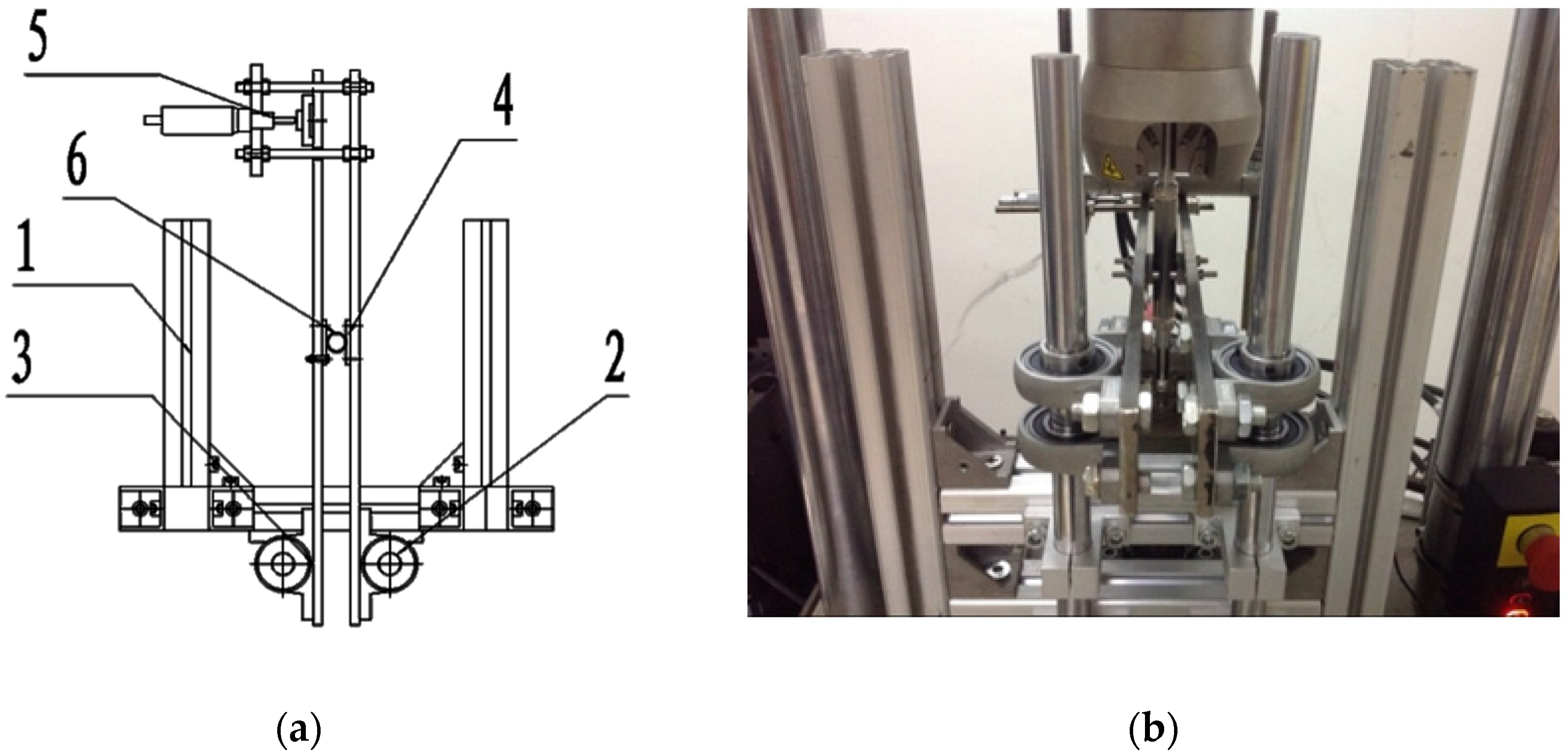
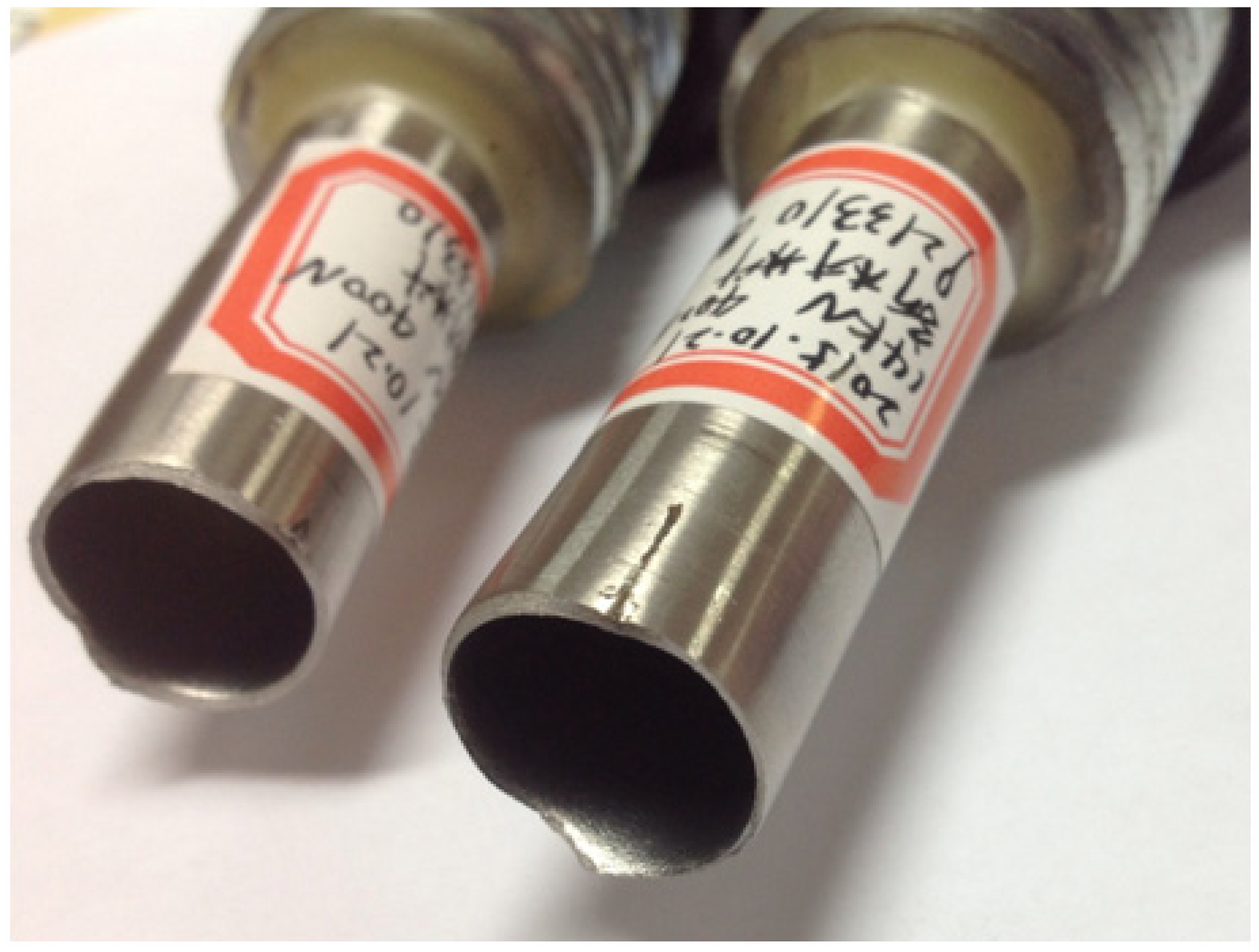
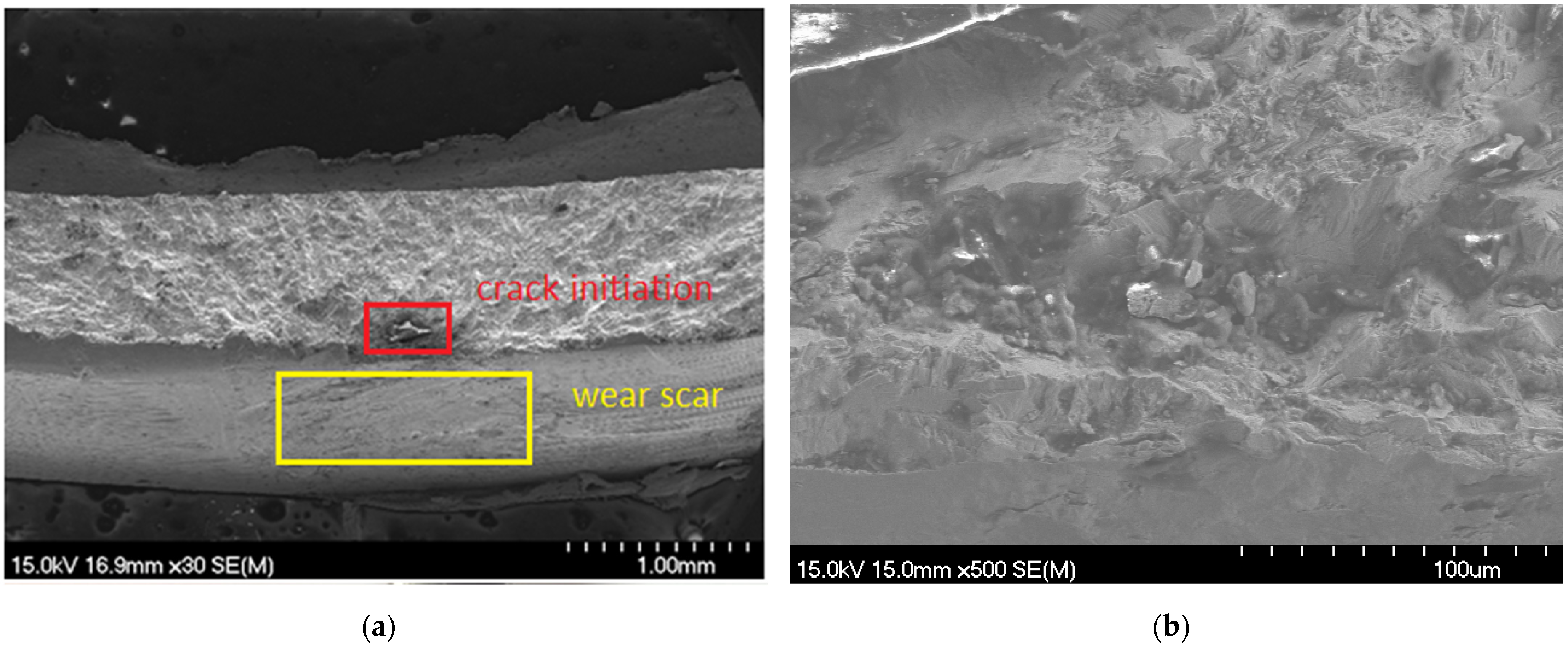
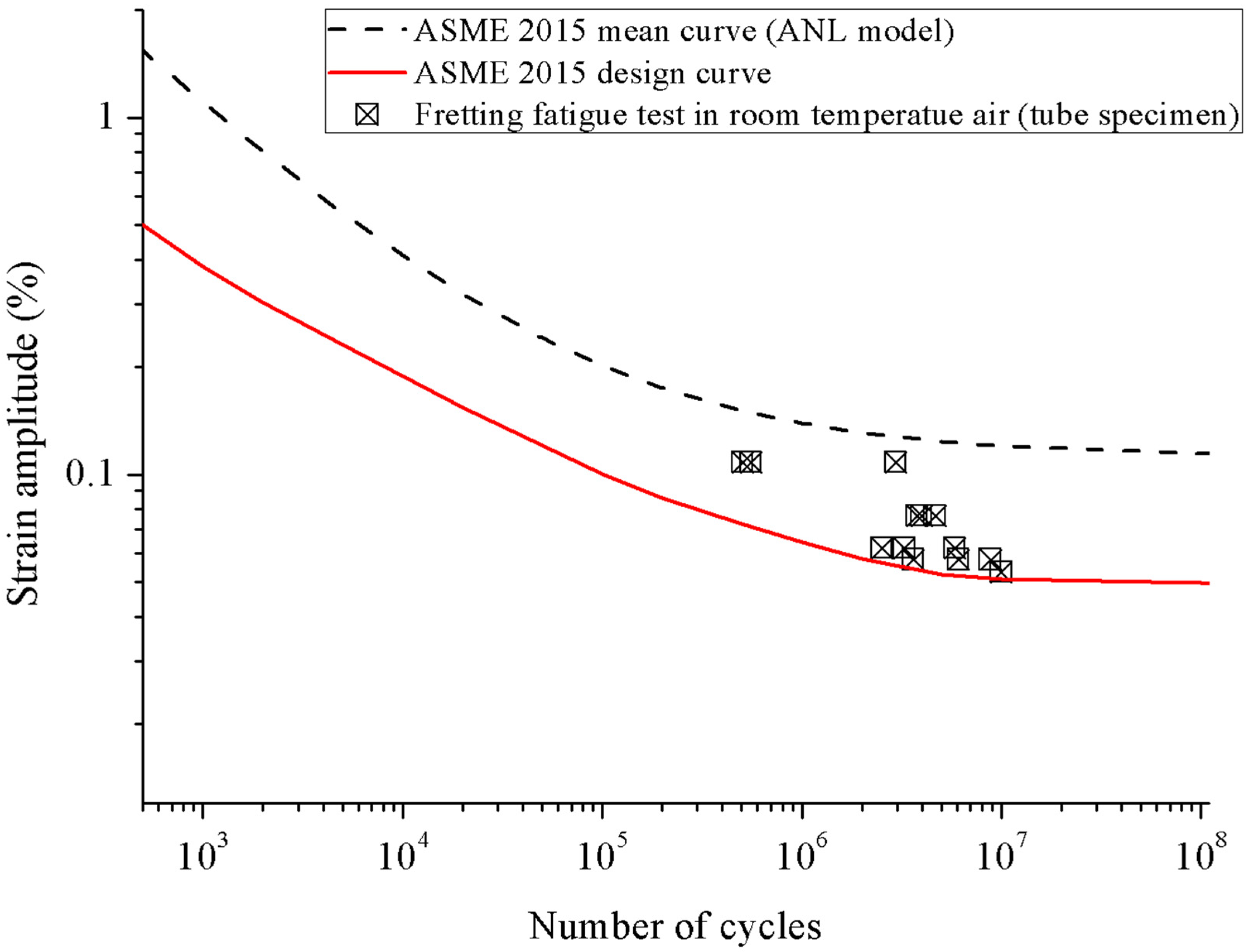
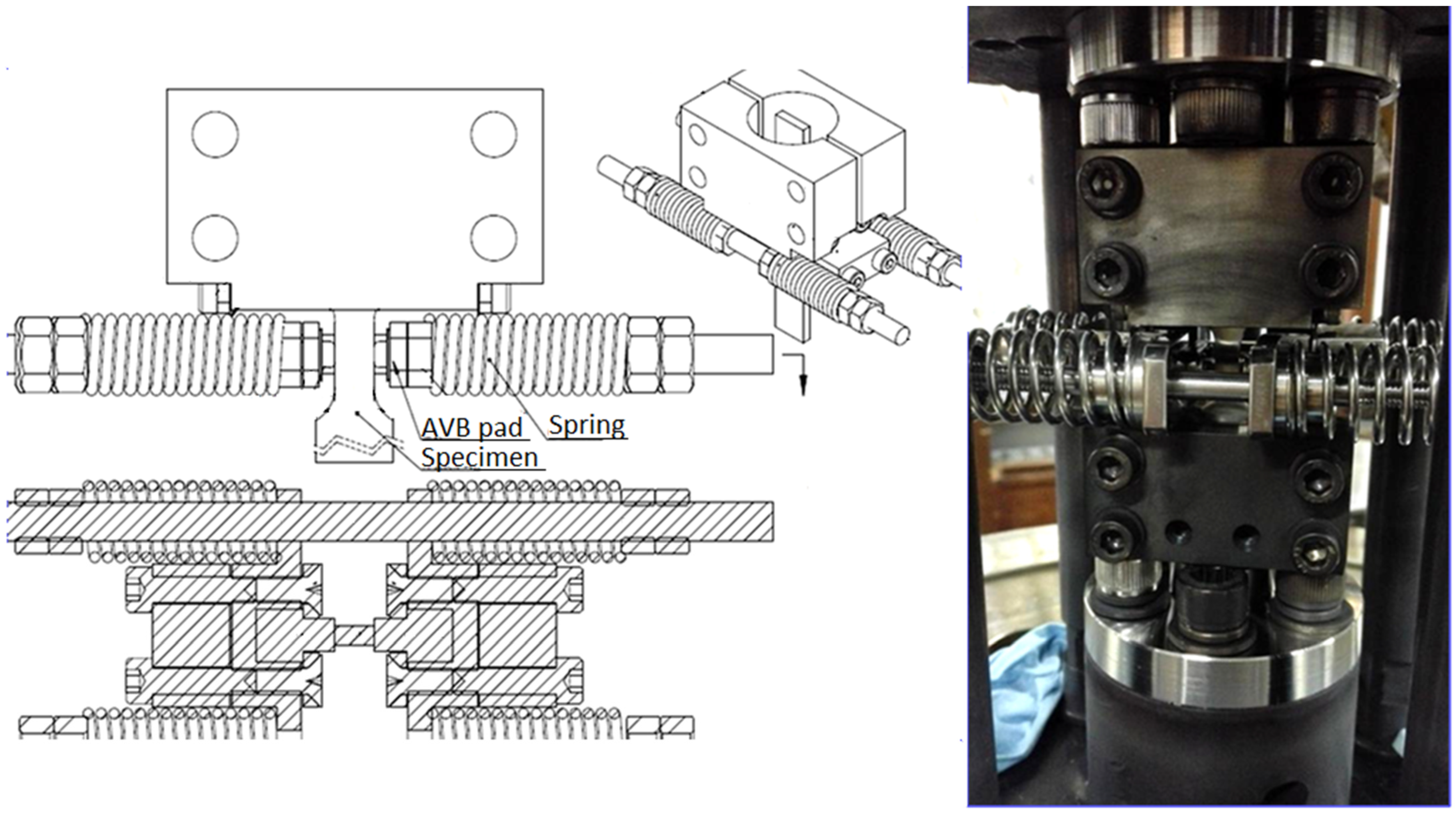



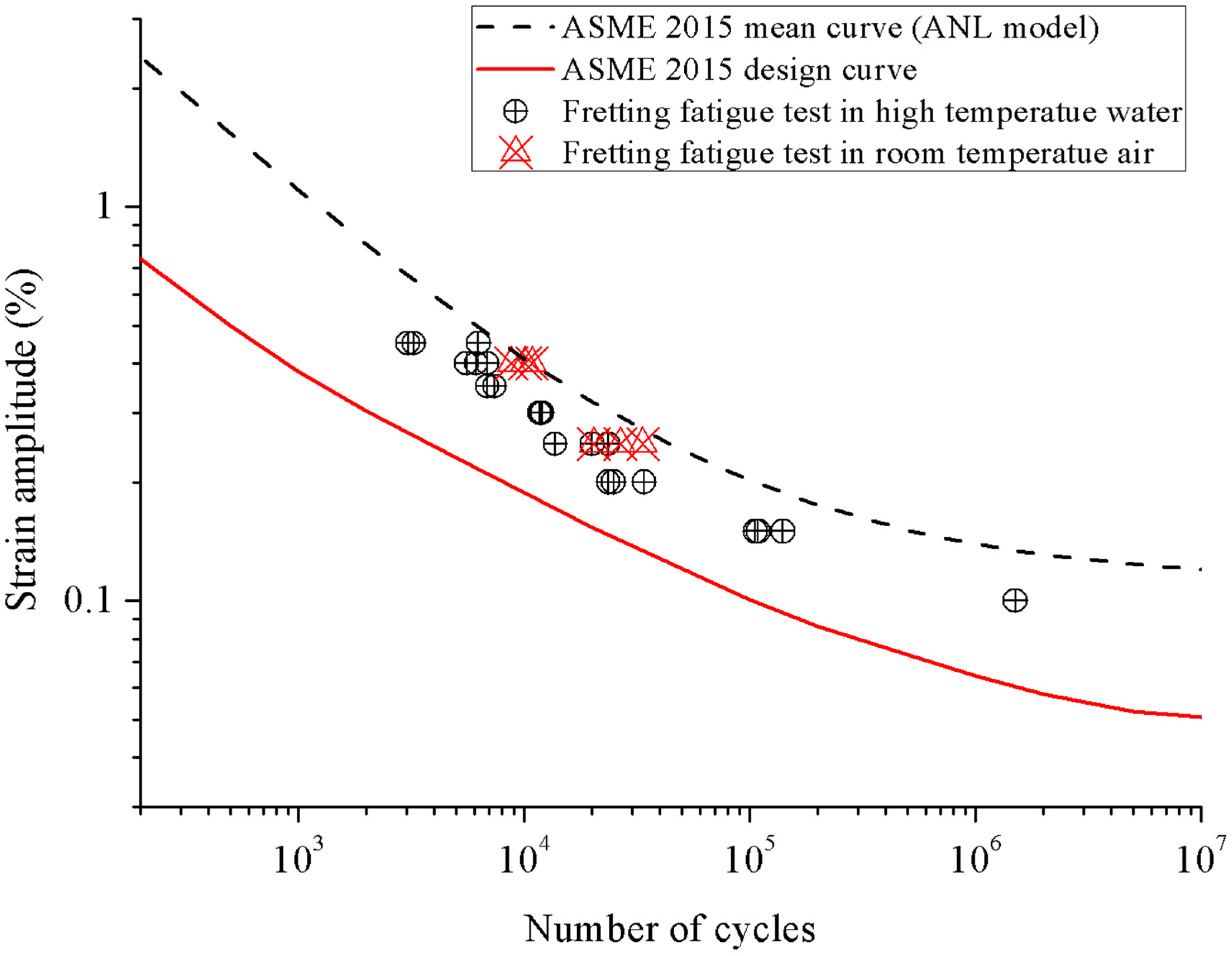
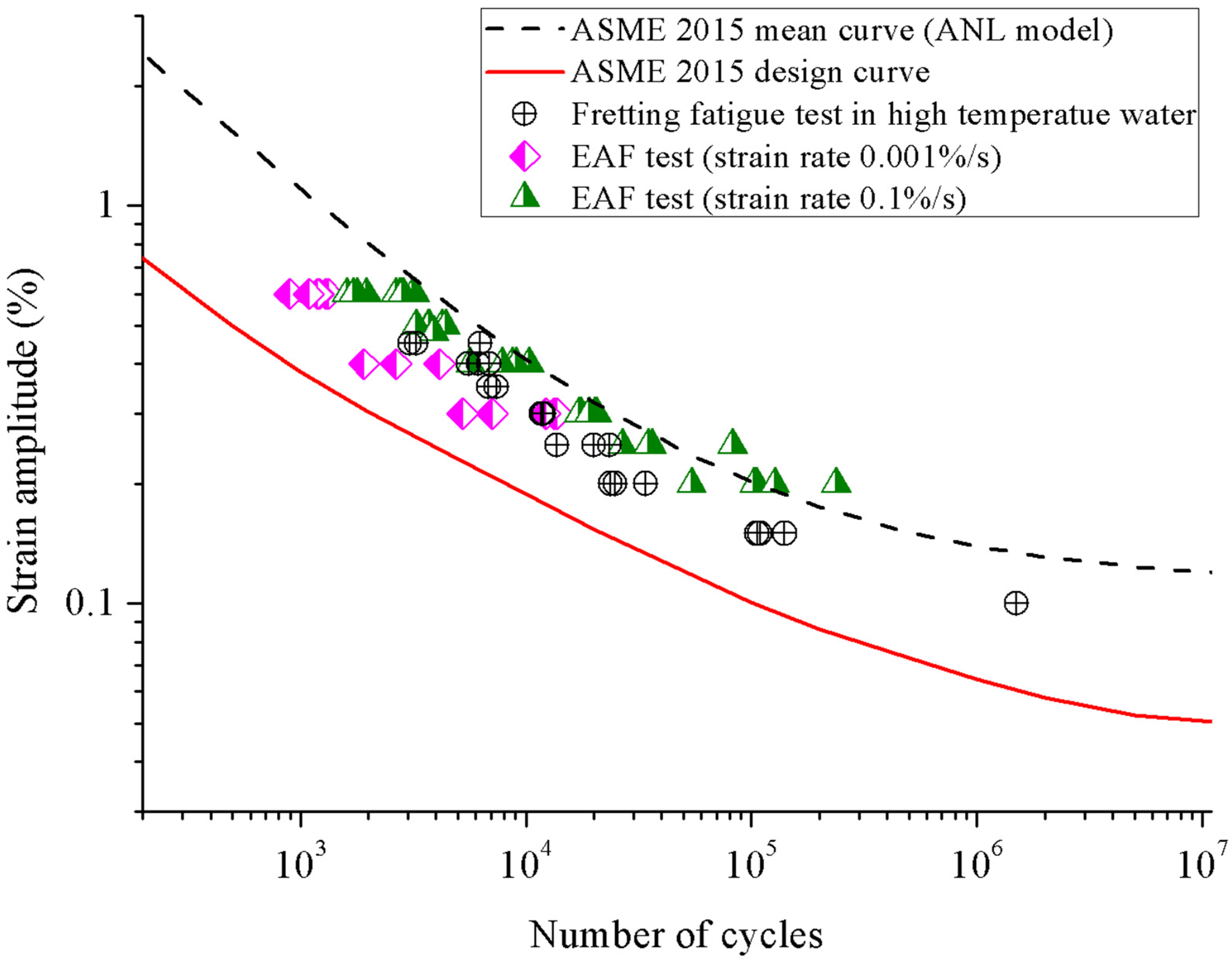

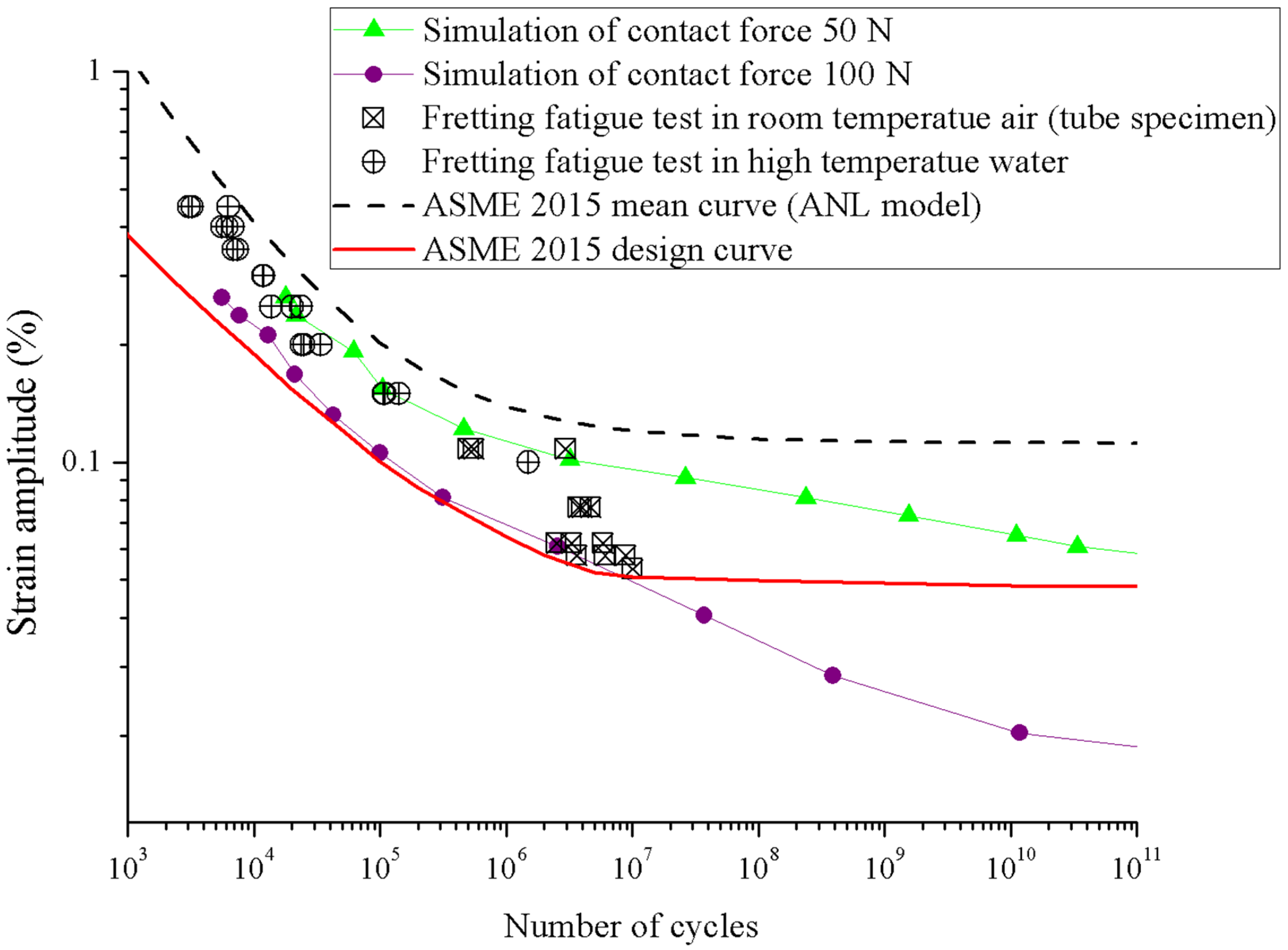
| Chemical Composition | Reference Value | Measured Value |
|---|---|---|
| C | 0.01–0.04 | 0.025–0.035 |
| N | - | 0.013 |
| Cr | 28–31 | 29.73 |
| Fe | - | 9.5 |
| Mn | ≤0.50 | 0.29 |
| P | ≤0.025 | 0.007 |
| Si | ≤0.50 | 0.29 |
| S | ≤0.015 | <0.001 |
| Al | - | 0.20 |
| Ti | - | 0.20 |
| Cu | - | <0.01 |
| Nb | - | <0.01 |
| Co | ≤0.10 | <0.01 |
| Ni | ≥58 | 58.7 |
Disclaimer/Publisher’s Note: The statements, opinions and data contained in all publications are solely those of the individual author(s) and contributor(s) and not of MDPI and/or the editor(s). MDPI and/or the editor(s) disclaim responsibility for any injury to people or property resulting from any ideas, methods, instructions or products referred to in the content. |
© 2022 by the authors. Licensee MDPI, Basel, Switzerland. This article is an open access article distributed under the terms and conditions of the Creative Commons Attribution (CC BY) license (https://creativecommons.org/licenses/by/4.0/).
Share and Cite
Tang, L.; Qian, H.; Li, C.; Wu, X. Fretting Fatigue Test and Simulation Analysis of Steam Generator Heat Transfer Tube. Metals 2023, 13, 67. https://doi.org/10.3390/met13010067
Tang L, Qian H, Li C, Wu X. Fretting Fatigue Test and Simulation Analysis of Steam Generator Heat Transfer Tube. Metals. 2023; 13(1):67. https://doi.org/10.3390/met13010067
Chicago/Turabian StyleTang, Lichen, Hao Qian, Chen Li, and Xinqiang Wu. 2023. "Fretting Fatigue Test and Simulation Analysis of Steam Generator Heat Transfer Tube" Metals 13, no. 1: 67. https://doi.org/10.3390/met13010067






